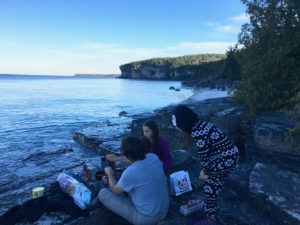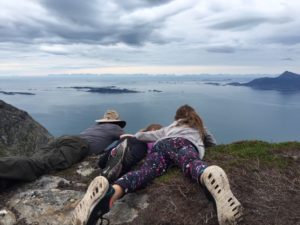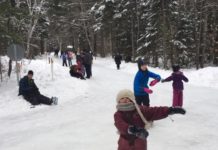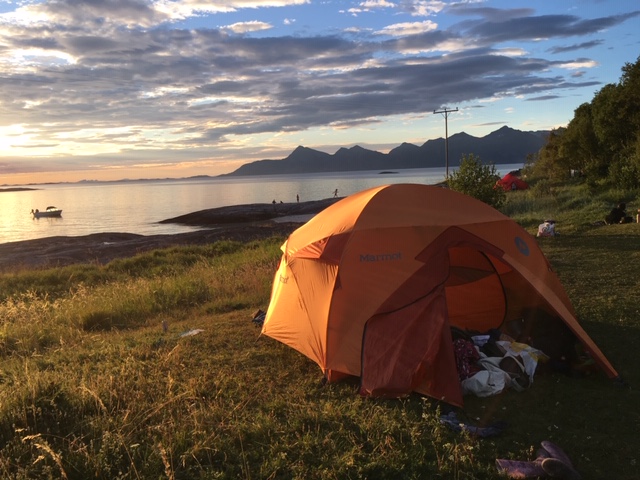Backpacking and camping in Arctic Norway for 9 days was our first experience to backpacking camping as a family. We soon discovered that this is the kind of camping we wanted to do. Camping on a beach under the midnight sun after a hike to a nearby mountain is a cherish camping memory that we will never forget.
This was our first introduction to backcountry camping and since then we have backcountry camped overlooking Norway’s fjords and hiked, canoed and kayaked our way to campsites in Ontario as a family.
You would think not having the car nearby would make you nervous, but it was liberating to go from car camping to backcountry camping. To become a minimalist camper and just bring what you can carry in a backpack.
We love backcountry camping because it allows us to have longer outdoor adventures and explore deeper into parks as a family. The crowds disappear once you passed the day tripper zone.
Here is how we plan our family backcountry camping adventures and what you need to know before you go camping in the backcountry.
Tents for backcountry camping Buying a tent can be expensive but backcountry camping in comfort requires a good quality tent. You need to think about how many people are going to be in the tent and how long or big are. I like to have head room and am not a fan of narrow spaces, so I opted for a dome shaped tent, that holds my family of 4, that has quite a bit of head space. Backpacking with a 4-person dome means splitting up the tent pieces to distribute the weight.
Weight is a major concern when it comes to tents and the lighter they are the more expensive they will be. Seasonal ratings are a consideration as well when backcountry camping during the winter. Do your research, ask questions at outdoor stores and look at the reviews. Check out backcountry tents here
Backcountry Camping Checklist
Tent
Backpacks
Pads
Sleeping bag
Matches
Outerwear
Camp stove (primus)
Mess kit
Food
Water purification
Shovel (red) (only if you are camping without designated toilets)
Knife
Flashlights
First Aid kit
Bear Spray (when in bear country)
Bear bag (to hoist your food out of their reach)
Rope
Biodegradable soap
Toilet paper
Maps
Compass
What do you need to backpack camp comfortably and safely?
Portable chargers for your cell phone
Bug spray
Hatchet (if you plan on building fires – we generally do not make fires)

Backpacks
When it comes to choosing a backpack the most important is to pick a backpack that is properly sized. Waterproofing, capacity and water storage will not matter if the weight is not properly on your hips and the shoulder straps are not keeping it snug to your back. This is where a little expertise from a friend experienced in backpacking or helpful staff at an outdoor store can save your outing. The backpack should also have features like a rain cover, able to access the backpack from the bottom, adjustable straps on sides to adjust the size of the backpack, different sizes of pockets and extra pockets for water bottles and walking sticks.
Backcountry camping cooking
Best thing we ever did was to invest in a backcountry cook set, primus camp stove for backcountry camping and quality water filter. It is impossible to carry all the water you will need on a trip.
Backcountry cook set
A backcountry cook set is a cooking set with everything you need to cook and eat in the backcountry. All the pieces fit nicely together so they will take little space in your backpack. Our backcountry cook set for example has room for our camp stove, pot for cooking and cutlery and bowls for eating. It has a little rubber lined canvas bag around the cook set we use to wash our dishes in the backcountry.
Water purifier pump
We always bring individual water bottles for each backcountry camper when we start our backcountry hike. However, water only last so long and water is heavy to carry. We have used a water purifier pump on our trips and find that this works well on our travels. The water pump takes little space and filters out what you would encounter in backcountry water sources in North America.

Backcountry Cooking
Bringing nonperishable items are best for backpacking as is planning every meal before you go backpacking. We mix it up with dehydrated lightweight meals made for backcountry, a favorite canned meal and a list of snacks and items of energy and comfort.
Here are some fresh items that will keep for a couple of days. Snacks
– Bagels, bread, chocolate, crackers, cookies, nuts, granola bars, hard cheddar cheese, popcorn, hot chocolate sachets, cured meat, oranges, apples and carrots.
Safety tips
A great way to start backpacking is to start with small trips first. Also make sure you are fit for the activity you are going to do on your backcountry trip. Choose well-known marked trails with well-maintained backcountry camping sites for your first trip. This makes it easier to navigate as well as they tend be better equipped with rustic but proper toilets and clearly marked spaces for campsites. Some established sites have poles to hang your food to keep it away from bears.

When you are camping it is important to never store food or eat in your tent. EVER This includes never storing your toothpaste, toothbrush or any toiletries in your tent as well. Even the smell of these items from a past camping adventure in your backyard can attract unwanted and dangerous (for the humans and the bears) attention.
Always store food and toiletries hanging up in a tree at least 4 – 6 meters high and well away from the tent in a bear bag or bear canister.
How to put up a bear bag can be done in many ways check out these detailed instructions to hang up a bear bag : https://momgoescamping.com/how-to-hang-a-bear-bag/
What you should do before you leave
Make sure you have researched and booked you backcountry site and have a printed-out map to your campsite. Checked that all your camping gear is functional and that you know how to use your equipment before your head outdoors. Make sure you check the weather forecast and bring appropriate clothing. It is also important to check local knowledge of unexpected changes in weather and the possibilities in some regions of summer blizzards or flash flooding.

Packing tips
First gather all your camping gear, clothing, food and toiletries. Share the burden with your fellow backpackers in keeping with their size and their abilities. For us, someone takes the poles, and someone takes the tent, and someone takes the tent fly. Put your sleeping bag on the bottom of the backpack with your heavy items like tent poles and camp stove and beaver food items. Role your clothes to minimize the space they take in your backpack. Have your food and snacks you are eating while hiking on the top of the backpack. We like to attach our sleeping pads on the outside of the backpack to give us more room.
What you think you need for backcountry camping but really don’t
– A pillow. Instead of a pillow fill your sleeping bag sack with some clothing.
– Leave your deodorant at home, because you do not want to carry the extra weight and it also can attract insects.
– Lantern use a flashlight or headlamp.
What you don’t think you need but probably do
Plastic bags for your garbage and your dirty clothes. Wet wipes
Camping and backpacking essentials
Campsite gear
-Tent, poles and stakes
-Sleeping bags
-Sleeping pads
-Rope
-Bear bag
-Flashlights
Camp kitchen
-Camp stove
-Backcountry cook set
-Camp food: dehydrated meals, nuts, bagels, cheese, oranges, and chocolate
-Biodegradable dish soap
-Water filter
More Camping
Read more about tent camping that I wrote for Camping Tips For Everyone








